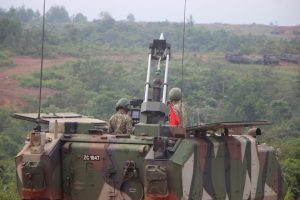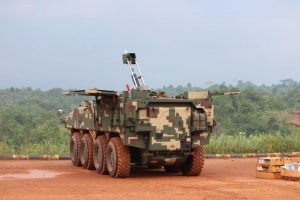SHAH ALAM: Locally developed weapons. The Science & Technology Research Institute For Defence (STRIDE) is collaborating with the armed forces and the National Defence University of Malaysia (UPNM) to develop a 12.7mm sniper rifle and a 120mm mortar. Defence Minister Mohamad Sabu told Parliament today said both weapons were still under the prototype stage and under development.
He said the prototype of the weapons would be handed over to the armed forces and selected security agencies for testing and evaluation. “Once the testing and evaluation is completed and it is found to be suitable for the end users it will be offered to a chosen defence company for manufacturing and marketing,” he said when responding to oral questions at the Dewan Rakyat. He did not revealed at what stage is the development of the sniper rifle and 120mm mortar.


Mohamad said the ministry will find ways to ensure that the local defence industry remain relevant and to reduce the dependancy on foreign arms manufacturers.

For the 12.7mm or .50 caliber rifles, the Army and the police are currently using the Barret .50 caliber rifles and one has to wonder if there is a need for a locally developed one. That said Indonesian state owned arms manufacturer Pindad has already produced a 12.7mm sniper rifle so that’s probably the inspiration. Anyhow, as you are aware that the army has a small number of 120mm mortars, integrated with the Adnan and Gempita APCs. These are the Thales 120mm Rifled recoiled Mounted Mortar (2R2M) system. Infact the Army has more 81mm mortars in service compared to the mounted 120mm system.
The fact that they choose a 120mm system to be develop is a probably that they think the Army should be equipped with a longer range system for its units. Typically a 120mm mortar has a range of 200 meters to 7,200 meters compared to the 81mm, with a range of 70 meters to 6,500 meters.
However, most modern 120mm mortars are now towed as they are too heavy to be lug around especially with the shell typically weighing around 14kg compared 4.15kg for the smaller 81mm mortars.
If indeed the locally developed 120mm mortar is put into service it is likely to be towed, leaving the 81mm and 60mm mortars with specialised units like the GGK and the 10th Para Brigade. It is unclear whether the Army actually wants these.
— Malaysian Defence
If you like this post, buy me an espresso. Paypal Payment
View Comments (34)
Great news indeed. Even better if they could repurporse some of the condor or sibmas as mortar carrier.
As for the sniper rifle, if Stride or SMEO have the expertise to produce the barrel they already have one foot into producing malaysian-made .50 cal rifle. In conflicts in middle east, there are plenty of examples of sniper rifle that is made using NSV heavy machine gun barrel.
Hell even the MILF had their own "barit" .50cal and even 40mm grenade "sniper rifle"
Possible.
A mortar is basically 1910s technology. And we definitely need more 120mm mortars. If a cheap local mortar can be developed, it can replace the Model 56s at lower cost and provide the infantry battalions with a powerful organic indirect fire weapon.
The key to employing mortars in today's battlefield however, is the networking with observers and fast and accurate computation for quicker response time.
I don't think we even have mortar and artillery computer systems. Do we? I only see people waving bits of paper around.
So we need to invest in these as well. Hopefully we can, with savings from purchasing a lower cost local mortar.
A few years ago STRIDE bought a 120mm from Slovakia and there are photos of live firings carried out. This was supposed to be the basis of a 120mm lightweight mortar STRIDE was going to develop.
No doubt some will be elated at the news but the questions to ask is how many locally developed mortars and rifles the MAF needs and how they will compare in price and performance to ones sourced from abroad.
Dundun - ''Hell even the MILF had their own “barit” .50cal and even 40mm grenade “sniper rifle”
News reports at that time had them supposedly being forged in Malaysia but this turned out to be untrue.
Chua - ''The key to employing mortars in today’s battlefield however, is the networking with observers and fast and accurate computation for quicker response time.''
That is the key to everything actually.
Chua - '' don’t think we even have mortar and artillery computer systems. Do we?''
Had hand held ballistic computers for decades...... One we have now - for arty and mortars - includes Morfire. For the G-5s we also got a South African FCS sold by Thales.
Chua - '' it can replace the Model 56s at lower cost''
A mortar can never totally replace arty; which is why some armies haven't gone down the 120mm route.
A howitzer is more accurate, has higher response time and superior penetrating ability.
Eventhough this news came from menhan parliament report, until they really launch it, its just another news (not good news). Its no different than the kereta terbang made in malaysia news
hopefully those new 50 cal rifle wont be as bad as our locally produce styer.
Reply
Who said the locally made Steyrs are bad. I have shot both and cannot find much difference.
@Azlan
>"A howitzer is more accurate, has higher response time and superior penetrating ability"
Not our very outdated 1956-era shorty pack hows.
Well, so we do have handheld ballistic computers, that's good.
Given the existing 2R2M mortars will continue to be used, let's say 25 battalions equipped with 6 120mm mortars each, plus a few training weapons - about 170 weapons? That isn't a lot to achieve economies of scale with.
120mm mortar? (facepalm)
How many 120mm mortar does the army need? Does the army see the 120mm mortar as a replacement for the 105mm pack howitzer? How does this makes the local defence industry relevant?
Another thing is the ease of use. Just see how high the barrel is for the soldier to load the 120mm mortar. And that is for a tall westerner, not a short asian.
http://pds27.egloos.com/pds/201402/21/60/f0205060_5306ffed77a6c.jpg
http://s1.dmcdn.net/v/OYtQY1RaBVcJEjjTN/x1080
Why IMO it is easier for us asians to operate the 105mm howitzer rather than a 120mm mortar.
And if you really want some 120mm rifled mortar, you can ask USMC nicely about their 66 nearly brand new retired M327 120mm mortars and you could probably get them for free.
The slovakian 120mm mortar that the R&D could be based on is a smooth bore design, compared to the rifled design of our current 120mm mortar (which is same rifled design as the USMC M327 mortar). So it probably cannot use the current motar shell in the inventory. It was actually developed for the austrian army and now marketed as the hitenburger mortar.
If you really want to R&D something that gives a meaningful impact, some things i can think of...
- accessories for M4. hand guards, polymer flip up sights, polymer magazines
- reverse engineer the RPG-7
- comfortable armor plate carriers designed for smaller malaysian statures
- armor plate carriers with flotation system for amphibious or maritime operations
- personal body cooling system for armoured vehicle operators for open hatch operations.
- compact PDW-type weapon based on the AR15 for armoured vehicle operators (for ease of use in the tight confines of a tank or IFV)
- Study into IED-type mines with EFP
- rapid modular components to convert any civilian vehicle of opportunity doublecab 4x4 into a weapon carrier.
- if we now have jammers for drones, why not handheld jammers for UGV like the hunter?
- proprietary control software conversion for commercial drones like the DJI to limit data leakages
Oh and please dont even think of designing from scratch your own light tank...
I can not say it is a good idea or not. Maybe just a simple question. Is it for real and why trying to develop bigger weapon if standard rifle also failed?